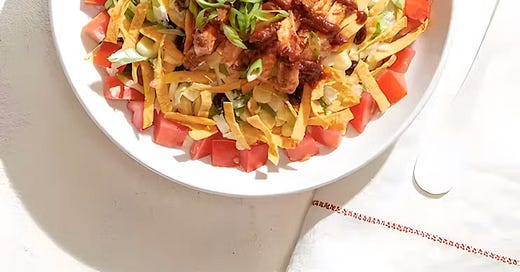I was running late to my flight last weekend and realized I was about to sit on a 5-hour flight without a meal. Seems forever ago when a cross-country trip would include some type of cafeteria-style lunch — a slab of meat loaf, an apple sauce, a cube of carrot cake. Now, you’re at the mercy of the cheese boxes and $15 hummus dip. I darted into the California Pizza Kitchen outside my gate and grabbed a BBQ chicken salad before the attendants closed the door behind me.
Two hours into my flight, my stomach growled, waking me from a nap. It was time. Have the tray tables gotten smaller? They’re like the size of an iPad now — I always feel like I’m playing make-believe tea-time on a princess toy set. I gently removed the salad’s cover and the condiments. I balanced a full cup of ranch dressing while peeling open a bag of tortilla strips. I unearthed the container of sweet barbecue sauce that turns a lifeless box of lettuce into a festive culinary explosion. As I sat up in my chair to get a handle on things, I jostled the table with my left knee and the barbecue sauce tumbled onto the woman’s leg next to me. I was horrified. She was dressed well, wearing cream sweatpants and a designer bag.
“Oh my God,” I gasped, as I searched for napkins in the store bag. "Here, let me —”
The woman laughed, as she dabbed at the maroon bruise on her thigh with some ice. “Don’t worry about it,” she smiled. “They’re Amazon.”
We were flying back from Maui for our annual Spring Break trip, which conveniently coincides with my birthday. We don’t shop a ton while we’re on vacation, but I do like stopping at the outdoor mall in Wailea to see what the surf brands like Volcom and Billabong are up to. Years ago, I was doing some light consulting for companies in this sector, who never quite righted the ship after a prosperous ‘80s and ‘90s. Eventually, they were consolidated and owned by the same company, who filed for bankruptcy a couple months ago.
“This shopping center must be struggling,” my wife lamented. “All these stores are having a closing sale.”
“Well, surf brands aren’t as in-demand as they were decades ago. Even surfers don’t wear surf labels,” I answered.
An hour later, I was at the beach with my son, looking at his boardshorts. They were cool — blue, geometric print, cut above the knee.
“What brand are those?,” I wondered. He shrugged. My son — like many sons today — wears Crocs instead of Jordans. Blank T-shirts instead of giant logos.
My wife overheard. “I got them on Amazon. They were cheap.”
“You’re part of the problem!” I cried.
I could judge my son for not caring about brand value. I could attribute the surf industry’s collapse to his mom for buying generic Chinese fast-fashion. But this past Winter, for the first time in many years, I bought no-name snowboard pants from Amazon. Typically, I wear authentic gear on the mountain from 686 and Burton. But, for years now, I’ve been hoping that the legitimate outerwear brands would offer oversized bottoms. They never caught up with the fashion trend, and then I was served an ad for the exact pants I was looking for.
Typically, snowboard pants can be hundreds of dollars. These were $60. I’ve worn them on three snow trips now and they’re some of my favorite pants I’ve ever owned. Comfortable, durable, perfect fit, and no branding. I received lots of compliments. Even from my son.
As an owner and operator of a brand for twenty-something years, and now as a steward of Disney, I think about Brand more than the average person. Brand is incredibly useful to navigate an ocean of diverse product options. There really is not much of a difference between toothpastes, but sharp storytelling around a brand, woven with good design and compelling salesmanship make some logos stand out on the shelf more than others.
Fashion and Brand go hand in hand because we dress ourselves as a means of self-expression and identity. We adopt logos and brand markers to associate with personalities and lifestyles that are closest to our own. When I was growing up, I wasn’t a surfer, but those aforementioned labels like Quiksilver, Stüssy, and T&C Surf were the only options you had to choose from. I gravitated towards the ones that employed cartoons and graffiti in their graphics because I wanted to signal that I was an artist.
I was also a skater. So when skate brands became accessible in my teenage years, I made the migration, finding them more in-tune with my background than beach apparel. And once Streetwear (as we define it today) materialized in the late 1990s and early 2000s, I felt brands like Alife, A Bathing Ape, and Supreme most aligned with my worldviews and design tastes.
But they weren’t exact. I aspired to be like Tony Arcabascio, Jest, and Arnaud at Alife — street artists who cared about limited sneakers and curated retail — but, they didn’t mirror my love for Garfield or LA workwear. James Jebbia was my hero, but Supreme was very serious and its attitude was New York in flavor. My personality was open, self-effacing, and irreverent. And so, in 2003, when my friend Ben and I founded The Hundreds here in Los Angeles, a streetwear brand of our very own, we tailored it for our needs. As young gods, we made it in our vision…
[Remainder of this piece is for PAID SUBSCRIBERS only]





